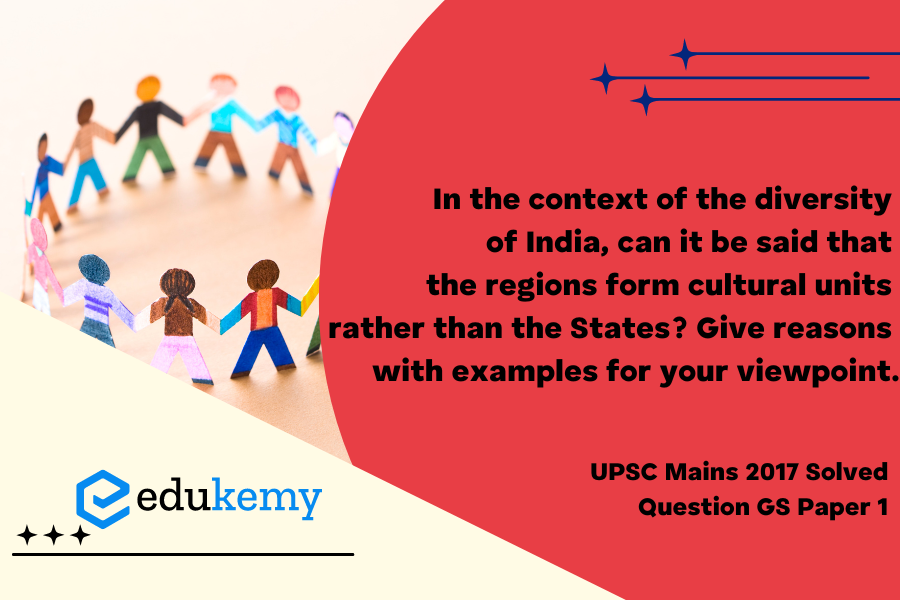In the rich tapestry of India’s cultural diversity, the debate over whether regions or states serve as more cohesive cultural units is a nuanced exploration. While states are administrative and political entities, often demarcated along linguistic and administrative lines, it is essential to delve into the deeper, more intricate layers of regional identities. India’s mosaic of traditions, languages, and customs is often better captured by the organic development of cultures within distinct geographic regions rather than by the administrative boundaries of states. Take, for instance, the vibrant celebration of festivals like Onam in Kerala, Diwali in North India, or Pongal in Tamil Nadu. These festivities transcend state borders, reflecting shared cultural practices that bind communities across political divisions. The culinary diversity, traditional art forms, and historical narratives often align more closely with regional affiliations than state demarcations, suggesting that cultural unity is more organically rooted in India’s diverse regions.
Tag: Society of India.
Contents
Decoding the Question:
- In Introduction, try to briefly write about India’s cultural diversity.
- In Body,
- Write How regions form cultural units rather than states.
- Also, write how states form cultural units.
- In Conclusion, try to mention a balanced view.
Answer:
India has been a country of multiple diversities like linguistic, religious, and cultural diversities since ancient times. After independence, various demands of reorganization of states on the basis of various aspirations comprising of cultural similarity, linguistic identity and others emerged from different parts of India. Though the government reorganized various states and also formed new states but cultural units have been intact in India till this day.
Regions form Cultural Units:
- Cultural Homogeneity within Regions: Regions often exhibit a higher degree of cultural homogeneity compared to the states. For example, the various regions within the state of Rajasthan, such as Mewar, Marwar, and Shekhawati, have distinct cultural characteristics, including language dialects, music, dance forms, and cuisine.
- Interconnectedness and Cultural Exchange: Geographically contiguous regions in India often share similar cultural practices and have historical ties. The Northeastern states of Assam, Meghalaya, Manipur, etc., form a region characterized by unique cultural diversity, shaped by shared historical and geographical connections.
- Influence of Local Geography and History: The geography and history of a region play a significant role in shaping its cultural identity. Kerala, for example, consists of regions like Malabar, Kochi, and Travancore, each with its cultural practices influenced by historical events and interactions with neighboring regions.
- Regional Languages and Dialects: Regions within a state often share a common language or dialect, contributing to their cultural unity. In Tamil Nadu, Chennai, Madurai, and Coimbatore have their dialects and cultural nuances, adding to their distinct regional identities.

States form Cultural Units:
- Cultural Diversity within States: Each state in India has its distinct cultural identity, characterized by language, traditions, festivals, cuisine, and historical heritage. For example, Punjab is known for Punjabi language, Bhangra dance, and Baisakhi festival, highlighting its unique cultural unit.
- State-Level Cultural Policies: States have the autonomy to formulate cultural policies and promote regional arts, literature, and heritage. West Bengal actively supports cultural initiatives like the Kolkata International Film Festival and Tagore Festival, reinforcing its cultural unit.
- Administrative and Political Boundaries: States in India are demarcated by administrative and political boundaries, which often align with cultural and linguistic factors. Tamil Nadu’s administrative boundary corresponds with its Tamil-speaking region, emphasizing its cultural unit.
- Historical and Socio-Political Factors: Historical events, social movements, and political developments within states shape their unique cultural identities. Rajasthan’s history of Rajput rulers and forts greatly influences its cultural identity as a distinct state.
- The composite nature of our culture shows that cultural units in India are not necessarily concurrent with states and beyond the boundaries of the formal division of states. The beauty of India’s diversity is the tolerance and coexistence of different cultures. Despite geographical diversity and climatic variations, India experiences an inherent unity. This is the reason that the civilizations got destroyed while Indian culture is present till today because the basis of development was spirituality and not materialism.
In case you still have your doubts, contact us on 9811333901.
For UPSC Prelims Resources, Click here
For Daily Updates and Study Material:
Join our Telegram Channel – Edukemy for IAS
- 1. Learn through Videos – here
- 2. Be Exam Ready by Practicing Daily MCQs – here
- 3. Daily Newsletter – Get all your Current Affairs Covered – here
- 4. Mains Answer Writing Practice – here


